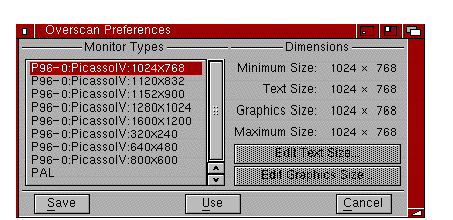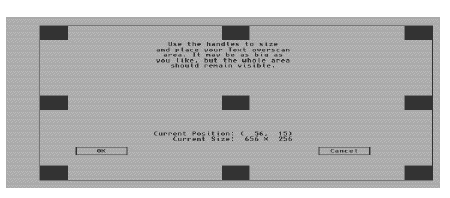
The Overscan editor, illustrated in Figure 5-4, enlarges the size of your screen to use the extra space normally unused around the edges of the monitor screen, known as the overscan area.

Overscan Preferences Editor Window
The Monitor Types available reflect the monitor drivers that are currently active. Monitor files that are in DEVS:Monitors when you boot are automatically activated. Each monitor type controls a set of display modes, called a display group.
When you change the overscan values for a particular monitor type, all modes within that type are affected. To change the overscan values for a monitor type, select its monitor type from the scrolling list. The selected group is highlighted. See Chapter 7 for listings of the maximum available overscan sizes for each display mode.

The Overscan editor allows you to set two different types of overscan: Text and Graphics. Most users can ignore the difference and set both to the same maximum value appropriate for their monitor. Having two settings can help those who use a television set as a monitor or whose monitor is unable to display a sharp image across its entire width.
The screen size and position set as Text overscan is the setting used by the Workbench screen. It can be any size between the minimum and maximum Dimensions limits, but it cannot be any larger than the Graphics overscan setting. If it is enlarged beyond the current Graphics setting, the Graphics setting is adjusted to match.
The screen size and position set as Graphics overscan are the limits within which the Text overscan area must fit and is the maximum for application screens in that display group. Graphics overscan can be any size between the minimum and maximum Dimensions limits. If the Graphics overscan area is sized or moved, the current Text overscan setting is adjusted as necessary to fit.

A television image normally extends beyond the edges of the screen itself, so that the outermost edges of the image are not visible. If some part of the Amiga's display runs off the edges of the screen on your television set or monitor or is distorted at the edges, use different Text and Graphics overscan settings.
Confine the Workbench and application screens that must remain legible to the visible area by setting Text overscan to the minimum size and centering it on the screen. The Graphics overscan area can be larger, allowing graphic images and other material for which legibility is less important to fill more of the monitor screen.

Selecting either the Edit Text Size or Edit Graphics Size gadgets displays a separate screen, illustrated in Figure 5-5, on which you graphically adjust the overscan size. The Overscan editor allows you to set two different overscan regions.

Edit Text Size Window
The black rectangles on the screen are handles and the line connecting the handles represents the outermost area where the Amiga's output can be displayed. Enlarge the display area by pointing to a handle, holding down the selection button, and dragging the handle to the edge of the screen. Only the active handle is visible on the screen when you drag it.
Moving any part of the handle off the screen or out of the viewing area over enlarges it, losing a portion of the visible image.
For monitor types other than NTSC and PAL, there are four arrow gadgets in the lower left area of the edit screen. The arrow gadgets allow you to shift the entire display area up, down, right, and left to center it. Move the display in the direction of the arrows by clicking on them. Depending on your monitor type, it is possible to move the display too far to the right or left, causing the monitor to go out of sync. This can result in the colors fading or a total disruption of the display. Because this condition can damage you monitor, it is important not to leave it this way for an period of time. If this happens, you can use the arrow keys on the keyboard to move the display back into position or press the Escape key, which undoes any changes you made and returns to the Overscan editor window.
Use the center handle to position the display area within the viewable area when the screen is not at maximum size. By dragging the handle, you can shift the display area in any direction to center it on your monitor screen.
The Current Position figures show the x/y distance in pixels from the upper left corner of the screen to the upper left corner of the display area. Current Size shows the size of the viewable area defined by the handles.
To accept changes and return to the Overscan editor, select OK. To exit the screen without accepting any changes and return to the Overscan editor, select Cancel or press the Escape key.

The different sizes of the overscan areas are displayed on the right of the Overscan window. The sizes are given in number of pixels, representing the width and the height of the screen.
For PAL or NTSC groups, the sizes correspond to the sizes for a standard High Res screen. If Multiscan is selected, the sizes for a non-interlaced Productivity screen are given. All other display modes in a group are affected proportionally.
